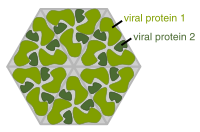
Photo from wikipedia
Herpes simplex virus type-1 (HSV-1) and type-2 (HSV-2) are prototypical alphaherpesviruses that are characterized by their unique properties to infect trigeminal and dorsal root ganglionic neurons, respectively, and establish life-long… Click to show full abstract
Herpes simplex virus type-1 (HSV-1) and type-2 (HSV-2) are prototypical alphaherpesviruses that are characterized by their unique properties to infect trigeminal and dorsal root ganglionic neurons, respectively, and establish life-long latent infections. These viruses initially infect mucosal epithelial tissues and subsequently spread to neurons. They are associated with a significant disease spectrum, including orofacial and ocular infections for HSV-1 and genital and neonatal infections for HSV-2. Viral glycoproteins within the virion envelope bind to specific cellular receptors to mediate virus entry into cells. This is achieved by the fusion of the viral envelope with the plasma membrane. Similarly, viral glycoproteins expressed on cell surfaces mediate cell-to-cell fusion and facilitate virus spread. An interactive complex of viral glycoproteins gB, gD/gH/gL, and gK and other proteins mediate these membrane fusion phenomena with glycoprotein B (gB), the principal membrane fusogen. The requirement for the virion to enter neuronal axons suggests that the heterodimeric protein complex of gK and membrane protein UL20, found only in alphaherpesviruses, constitute a critical determinant for neuronal entry. This hypothesis was substantiated by the observation that a small deletion in the amino terminus of gK prevents entry into neuronal axons while allowing entry into other cells via endocytosis. Cellular receptors and receptor-mediated signaling synergize with the viral membrane fusion machinery to facilitate virus entry and intercellular spread. Unraveling the underlying interactions among viral glycoproteins, envelope proteins, and cellular receptors will provide new innovative approaches for antiviral therapy against herpesviruses and other neurotropic viruses.
Journal Title: Viruses
Year Published: 2021
Link to full text (if available)
Share on Social Media: Sign Up to like & get
recommendations!